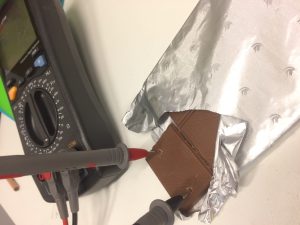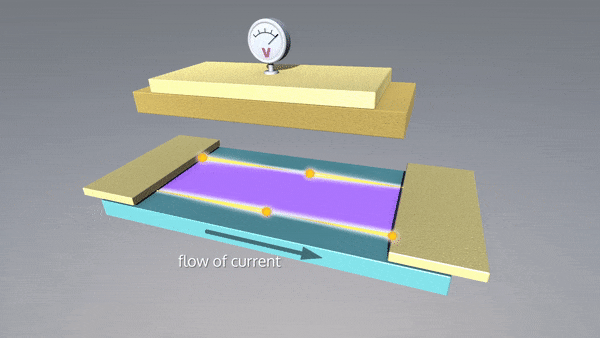Electrically, topological insulators resemble a chocolate block wrapped in foil: electrically insulating on the inside (the chocolate), but electrically conductive around the edges (the foil).
It’s a very useful analogy to describe a new type of material, but we decided to test whether it’s actually correct.
We tested four bars of chocolate, measuring the electrical resistance of the surrounding foil, and the chocolate. Results are shown below.
Topological insulators: what are they anyway?
Topological insulators are a type of topological material –a relatively new class of materials, first theoretically predicted in the 1980s, and not actually seen in the laboratory until the 2010s.
It’s newness can be seen by the fact that the Nobel Prize in Physics recognising topological materials was only awarded in 2016.
Once, physicists thought materials could be divided into only three types, in terms of their electrical properties:
- electrical conductors (like tin foil)
- electrical insulators (like chocolate)
- semiconductors (such as silicon)
But we now know there’s a new type of material: topological insulators conduct electricity along their surfaces (their edges, or boundaries) but they do not conduct electricity in their interior.
The experiment
 The block of chocolate is a great analogy for topological insulators, but is it actually correct?
The block of chocolate is a great analogy for topological insulators, but is it actually correct?
We tested four common bars of chocolate, testing the electrical resistance of the chocolate (the interior of the topological insulator) and the surrounding foil (the edge paths).
We found the aluminium foil surprisingly hard to measure, but at least the chocolate was confirmed to be electrically insulating. We declared Lindt the winner (partly on the basis of the delicious chocolate).
- Lindt: conductive foil, insulating chocolate, delicious
- Supreme: conductive foil, insulating chocolate
- Whittaker’s: weird gold-coloured, high-resistance foil, insulating chocolate
- Cadburys: no foil, insulating chocolate
2D topological insulators If you imagine a 2D ‘slice’ taken through your block of chocolate, you would have a rectangle of chocolate in the middle (insulating) with a narrow ‘edge’ around the outside of foil (conductive).
2D materials have particular interesting properties. For example, electron flow in those edge paths are ‘one way’, without the back-scattering that causes energy dissipation and heat in conventional materials. That means you can run an electrical current through them with almost no wasted dissipation of energy.
Studying topological insulators At FLEET

A topological transistor would switch off and on just like a conventional silicon-based transistor
FLEET will develop topological transistors, which would ‘switch’, just as a traditional transistor. The application of a gate voltage would switch the edge paths between being a topological insulator (‘on’) and a conventional insulator (‘off’).
Topological materials are investigated within FLEET’s Research theme 1, seeking ultra-low resistance electronic paths with which to create a new generation of ultra-low energy electronics.
FLEET is an Australian Research Council-funded research centre bringing together over a hundred Australian and international experts to develop a new generation of ultra-low energy electronics.
More information
- Discover topological materials research at FLEET
- Contact media@FLEET.org,au
- Connect @FLEETCentre
- Visit FLEET.org.au
- Watch Future solutions to computation energy use
- Subscribe FLEET.org.au/news

